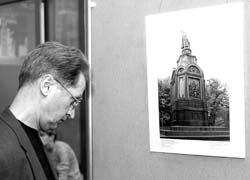More than 200 architectural monuments in Kyiv were created by Germans
Will we be able to preserve them?
The belfries of the Assumption Cathedral at the Kyiv Cave Monastery and St. Sophia’s Cathedral, the Ivan Franko Theater and the National Opera, the monuments to Prince Volodymyr and Taras Shevchenko, the Zaborovsky Gate, the main building of the Polytechnic, and many other well-known sculptures and structures — without which it is impossible to imagine Kyiv — were all created by German architects.
This year the German community of Kyiv is marking the 150th anniversary of the consecration of St. Catherine’s Lutheran-Evangelical Church on Luteranska Street and the 240th anniversary of the German community. In connection with this double jubilee, the embassy of the Federal Republic of Germany hosted an exhibit called “German-Made Monuments of Culture in Kyiv” organized by Ihor Vynnychuk, a professor of history at National Taras Shevchenko University. The exhibit features more than 30 photographs depicting well-known structures that illustrate German influence on Kyiv’s culture.
“This is the second exhibit at our embassy. We dedicated the first one to Germans who lived and worked in Kyiv,” says Reinhard Schaefers, Ambassador Extraordinary and Plenipotentiary of Germany to Ukraine. “I have been in Kyiv for 18 months now, and while walking about the city, I came to the conclusion that it is impossible to imagine the Ukrainian capital without foreign builders.
“Many of the structures that we see every day, including those near our embassy, were designed by German architects or people with German roots. I am very proud of this.”
The photos at the exhibition and the catalogue are not all the ones that Vynnychuk has taken. The historian says there are many buildings in Kyiv that are in disrepair, with peeling and cracked walls. They were not included in the catalogue and, unfortunately, there is no public interest in them. During his search for materials Vynnychuk was assisted by his students, who mapped out ethnic tours in Kyiv (e.g., Germans, Dutchmen, Poles, and others) as part of their course work. The scholar’s longtime cooperation with the German cultural center in Kyiv was also beneficial. As a result, in more than 10 years of studying the impact of German culture on Kyiv, Vynnychuk has gathered a lot of material and is now working on the book Germans at Kyiv University: the 19th-First Half of the Mid-20th Centuries.
“While exploring this subject, I came to the conclusion that the Germans had a considerable impact on the cultural and educational policies of Kyiv,” he said. “Four Germans were rectors of what is now Taras Shevchenko University. There were also about 100 German professors and instructors who were working there. Two Germans were Kyiv mayors. We owe the Germans even the contemporary look of the Botanical Garden near the university. I will also remind you that after World War Two, Germans built apartment houses in Kyiv’s Sotsmistechko and Syrets.”
History does not always know how to explain why the Ukrainians managed to lure some of Europe’s best architects to the southern part of the Russian Empire. Among them were Ivan Strom (Lutheran Church), Johann Gottfried Schaedel (belfries of the Assumption and St. Sophia cathedrals, the Zborovsky Gate), Peter Klodt von Juergensburg (the monument to Prince Volodymyr on Volodymyr’s Hill), Alexander Schile (the fountain in front of the Ivan Franko Theater), and many others. Vynnychuk told the story of how Schaedel, the creator of the majestic belfries, found himself in Kyiv.
“When Metropolitan Rafail Zaborovsky of Kyiv visited St. Petersburg in the 1720s and saw what the architect had created there, he lured him to Kyiv. No one knows how he managed to persuade him,” the historian said, “but after building the belfry of the Assumption Cathedral at the Kyiv Cave Monastery, the tallest (96.5 m) one in the Russian Empire at the time, he wrote on the payment list, ‘This is my most majestic creation.’”
At first glance, it is surprising that the creators of imposing architectural monuments bear German last names and Slavic first names, such as Ivan, Pavlo, Viktor, Heorhii, Matvii, and Oleksandr. Experts explain that many of them converted to Orthodoxy and Slavicized their names. In any case, the architecture of Kyiv experienced a strong influence of foreign artists and art patrons. One of them, Waclaw Horodecki from Poland, left us the House with Chimeras, the Art Museum, St. Nicholas’s Cathedral, and other architectural monuments. According to Vynnychuk, Jews also took part in the construction by funding magnificent projects. For example, the well-known owner of a sugar syndicate, Lazar Brodsky, sponsored the building of the Central Synagogue and what is now the Polytechnic (together with the Ukrainian sugar magnate Tereshchenko). The names of the finest representatives of other nations are immortalized in stone and bronze.
Today Kyiv is faced with the problem of how to save what history gifted us a few centuries ago. Historians cite the example of Spain, where 15th-16th-century architectural monuments look as if they have just been built, and Paris, where any construction is forbidden within five km of the city center. In Vynnychuk’s view, unless certain measures are adopted, the architectural monuments that have not been entered into the catalogue for esthetic considerations may face destruction in view of the current municipal policies. Unfortunately, the city authorities have turned a deaf ear to the proposal that Kyiv honor the names of the Germans who contributed to the creation of the city’s inimitable architectural ensemble — even at the Germans’ expense.
Vynnychuk says that his goal is “to teach children to embrace all things beautiful and represent Ukraine properly.” If our government does not help, the German government will. “Look, admire, and think,” he said in conclusion.






